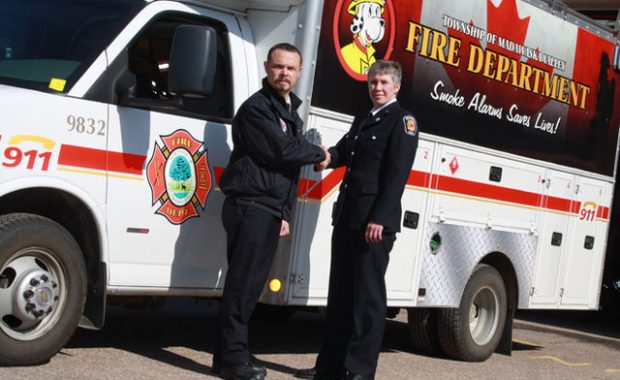BARRY’S BAY – Committee members met for their emergency preparedness meeting on April 16.
BE EMERGENCY READY,
SAYS COMMITTEE
With Emergency Preparedness Week right around the corner this May 5 to 11, emergency preparedness committee members are urging local residents to get prepared in the event of an emergency or disaster.
And while Emergency Management Co-ordinator Andy Peplinski acknowledges that most local residents are self-sufficient, he’s stressing to everyone the importance of being prepared.
“Self-preparation is so important,” he said.
What’s more, with various advancements in technology, there’s much that can be utilized in this regard, he added.
Primarily, the annual Canadian and National event, which began in 1996, aims to bridge the gap between individuals knowing and doing, according to Emergency Management Ontario (EMO).
According to the emergency organization, 85 per cent of Canadians agree that having an emergency kit or plan is important, however, about only four in 10 Canadians on average, are actually prepared or have an emergency kit.
Unfortunately, there will most likely always be individuals who are not emergency ready, Peplinski explained. But the more emergency professionals and committees work to increase awareness, and the more the message gets out there, the more likely people will get the message, the co-ordinator went on to say.
Because after all, being emergency prepared can save lives, Peplinski said.
According to EMO, three simple steps can help Canadians to become better prepared to face a range of emergencies. First, individuals should know the risks. Second, people should always have a plan made well in advance. Lastly, EMO encourages everyone to get an emergency kit – as does the emergency committee for Madawaska Valley.
In addition, people should be prepared to cope on their own for a minimum of 72 hours. And while emergency service officials will do their best to help everyone, those in urgent need will come first. So, it’s important people be prepared in the event that emergency officials cannot get to them right away, Peplinski went on to say.
And emergencies can strike at any time, the co-ordinator added.
In a country that borders on three oceans and spans across six time zones – emergency management can be difficult, EMO says. This is why it’s important emergency response management is a shared responsibility.
And although natural disasters, such as earthquakes or hurricanes may be beyond anyone’s control, there are ways to reduce risks and the impacts disasters can have on communities, families and individuals. It all starts with being prepared, according to the emergency orginization.
Simple things, like having a flashlight easily ready and available can really help, the Government of Canada stresses.
Although emergency kits are often personalized, a few key and basic-universal items can help almost anyone in an emergency, committee members, EMO and the Government of Canada agree.
A windup, solar or battery-powered radio can also prove to be beneficial, Peplinski added.
Other suggested items include sleeping bags or blankets, important identification documents, prescriptions, non-perishable food items, and of course, water.
According to EMO, at least two litres of water per person per day is necessary. Smaller bottles easily carried in case of an evacuation order are favourable. Food that won’t spoil, such as canned food, energy bars and dried foods should also be included. A manual can-opener and extra keys to the house, and car should also be included in an emergency kit. Smaller bills and change, as well as a copy of a person’s or family’s emergency plan are also essential, according to officials.
Any special items specific to one’s needs, like a MedicAlert bracelet, pet food or infant formula, for examples, should also be put away if applicable.
Story continues in the April 24 2013 issue of The Valley Gazette.
